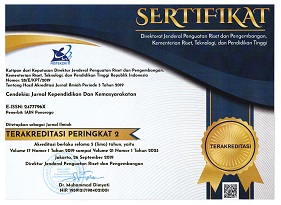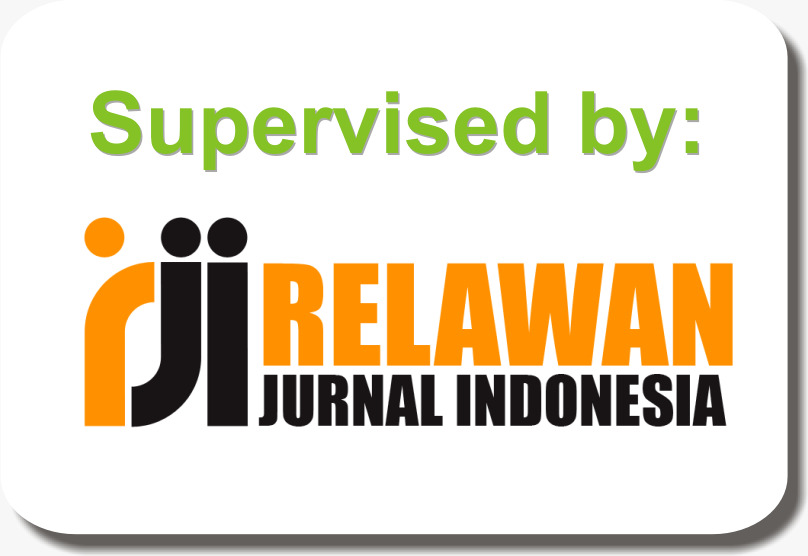BENTUK FUNGSI, DAN MAKNA KIAS DALAM JUDUL BERITA MAJALAH GATRA DAN PEMANFAATANNYA PADA PEMBELAJARAN BAHASA INDONESIA DI PGMI STAIN PONOROGO
DOI:
https://doi.org/10.21154/cendekia.v13i2.248Abstract
Abstract: One of the uses of language to convey messageis through written language,including printed media such as newspapers or magazines. The word choices in news,
both oral and written communication, are very essentialin order that the message can
beconveyedwell, even they prevail beauty. With a qualitative approach, this study was
aimed to uncover the types of figurative language how it functions and its utilization
in Gatra magazine and on students of PGMI STAIN Ponorogo.
Based on the research result, it revealed figurative language in the news titles
ofGatra magazine in 2013 to 2015. The figurative language used was (1) a simile
used as many as 5 times, (2) metaphor 23 times, (3) metonymy 25 times, (4)
anthropomorphisms 25 times, (5) Symbolic 17 times, (6) hyperbole 21 times, (7)
allegory 92 times, (8) periphrasis 25 times, (9) personification 22 times, (10) Innuendo,
(11) sarcasm first time, (12) synecdoche 16 times, (13) synesthesia 9 times, and (14)
proverb 2 times. Thus, the total of figurative words used in the headlines inGatra
magazineon 2013 to 2015 are as many as 267 times consisting of 14 types of figurative
language form. If it was ranged, the use of figurative language wasdominated with the
allegory type that was 86 times. Next, it is followed with metaphor and metonymy,
which appeared 23 times of use respectively. The third rank was the use ofperiphrasis
that was about 22 times, personification 20 times, followedwith the forth rank that was
synecdoche as many as 15 times. Then, the sequential low uses of figurative language
were Innuendo and sarcasm only once, proverb 4 times, simile 5 times, and synesthesia
8 times. Meanwhile, the function varied from one type of figurative language to others.
The use of figurative language was revealed to function variously, i.e.,to awaken,
shorten, beautify, explain, illustrate, visualize,enliven and stressed.
Downloads
Published
How to Cite
Issue
Section
License
Copyright & License
Please find the rights and licenses in Cendekia: Jurnal Kependidikan dan Kemasyarakatan. By submitting the article/manuscript, the author(s) agree with this policy. No specific document sign-off is required.
1. License
The non-commercial use of the article will be governed by the Creative Commons Attribution license as currently displayed on the Creative Commons Attribution-NonCommercial 4.0 International License.
2. Author(s)' Warranties
The author warrants that the article is original, written by the stated author(s), has not been published before, contains no unlawful statements, does not infringe the rights of others, is subject to copyright that is vested exclusively in the author and free of any third party rights, and that any necessary written permissions to quote from other sources have been obtained by the author(s).
3. User/Public Rights
The spirit of Cendekia: Jurnal Kependidikan dan Kemasyarakatan is to disseminate articles published as free as possible. Under the Creative Commons license, Cendekia: Jurnal Kependidikan dan Kemasyarakatan permits users to copy, distribute, display, and perform the work for non-commercial purposes. Users will also need to attribute authors and Cendekia: Jurnal Kependidikan dan Kemasyarakatan on distributing works in the journal and other media of publications. Unless otherwise stated, the authors are public entities as soon as their articles got published.
4. Rights of Authors
Authors retain all their rights to the published works, such as (but not limited to) the following rights;
- Copyright and other proprietary rights relating to the article, such as patent rights,
- The right to use the substance of the article in own future works, including lectures and books,
- The right to reproduce the article for own purposes,
- The right to self-archive the article,
- The right to enter into separate, additional contractual arrangements for the non-exclusive distribution of the article's published version (e.g., post it to an institutional repository or publish it in a book), with an acknowledgment of its initial publication in this journal (Cendekia: Jurnal Kependidikan dan Kemasyarakatan).
5. Co-Authorship
If the article was jointly prepared by more than one author, any author submitting the manuscript warrants that he/she has been authorized by all co-authors to be agreed on this copyright and license notice (agreement) on their behalf and agrees to inform his/her co-authors of the terms of this policy. Cendekia: Jurnal Kependidikan dan Kemasyarakatan will not be held liable for anything arising due to the author(s) internal dispute. Cendekia: Jurnal Kependidikan dan Kemasyarakatan will only communicate with the corresponding author.
6. Royalties
Being an open accessed journal and disseminating articles for free under the Creative Commons license term mentioned, the author(s) are aware that Cendekia: Jurnal Kependidikan dan Kemasyarakatan entitles the author(s) to no royalties or other fees.
7. Miscellaneous
Cendekia: Jurnal Kependidikan dan Kemasyarakatan will publish the article (or have it published) in the journal if the article's editorial process is completed. The editors of Cendekia: Jurnal Kependidikan dan Kemasyarakatan may modify the paper to a style of punctuation, spelling, capitalization, referencing, and usage that deems appropriate. The author acknowledges that the article may be published so that it will be publicly accessible, and such access will be free of charge for the readers, as mentioned in point 3.

















